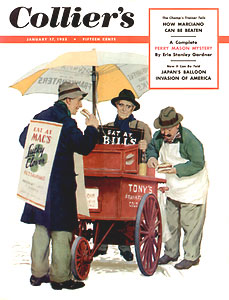Print Media 9
|
|
Magazines - the Early History
What U.S. magazine has the largest circulation. Do you think it might be Reader's Digest, TV Guide, National Geographic, or Time....? You might be surprised to learn that it's none of these. Modern Maturity with well over 20 million subscribers has by far the largest circulation. (We're excluding Parade here, since it's actually a newspaper supplement.) Modern Maturity, like many magazines, is an example of a magazine with unit specialization; that is, it appeals to target audiences with specialized interests. The entire magazine is considered a "unit" aimed at a specific audience. Trade magazines (or "trades") fall into this category. Some, such as Billboard, and Variety, are by paid subscription. Many are sent out free to "qualified" professionals. Mass media examples of the latter are Television Engineering, Videograhy, Government Video, and Millimeter. In these publications advertising is targeted to a specific reader niche. To qualify for a free subscription you must work in the field represented and have influence over buying some of the products advertised. In this way, printing and distribution costs are minimized and advertisers know they are only paying to reach their ideal (target) audience. Once you start working in a specialized field, you will want to subscribe to a number of these just to keep up on developments in your field. There are also magazines with internal specialization. Internal specialization suggests that within the magazine there are a variety of articles for readers with different interests. Although there used to be many of this type--Look, Saturday Evening Post, Colliers, etc--with the exception of Reader's Digest most have gone out of business. (Although some people would argue that Reader's Digest is a bit specialized because, unlike the others cited, it tends to appeal to an older, middle-class, conservative audience.) We'll talk more about the Digest in the next module. With this general background, we will flash back to the beginning of the history of magazines.
In case you are ever asked on "Hollywood Squares" or in a game of Trivia what the first English language magazine was, you will want to answer, Review. It was published in London in 1704. By the way, the publisher was Daniel Defore, the author of Robin Crusoe, in case you've read that rather famous book. It was some years later--1741 to be exact--that the idea of magazines came to America. As we've previously noted, Benjamin Franklin was involved, and so was Andrew Bradford. Unfortunately, neither of their first efforts got very far. Bradford's magazine lasted three issues. Franklin did a bit better; his folded after six issues. In 1743, The Christian History magazine tried its luck and was able to last a bit longer. It should be noted that these failures weren't necessarily the fault of the content. At that time literacy was limited and the publications had to appeal to the elite--a rather limited audience. The first really successful magazine in the United States was the Saturday Evening Post, first published in 1821. It lasted as a weekly publication until 1969, after which it appeared somewhat sporadically. The same can be said for another general interest magazine, Life. The latter is credited with establishing photojournalism. Life maintained a staff of top photographers that often won prizes for their graphic and moving news photos. The first issue, published in November 1936, is shown above.
In 1825, there were fewer than 100 magazines in the country; by 1850 the number had swelled to 600, and magazines were well established as a mass medium. At that time, many magazines also took a "viewpoint" on issues. For example, during the Civil War, which was primarily fought over the issue of slavery, northern magazines often espoused antislavery views, and southern magazines typically attacked these views. Thus, magazines served to strengthen the opposing views and reinforce divisions of thought--which in large measure fueled the war. We should note that Harrier Beecher Stowe's book, Uncle Tom's Cabin, which we've discussed previously, was first serialized in a magazine. Technological developments in typology, printing, and distribution also meant that the price of magazines dropped dramatically during this era. For example, the Saturday Evening Post sold for five-cents a copy. Further spurring the popularity of magazines was compulsory education, which meant that more and more people learned to read. Consequently, by 1900, there were more than 5,000 magazines in the United States.
By the 1900s there were hundreds of thousands of European immigrants living in the United States. They had in large measure been attracted to the U.S. because many new jobs were being created by industrialization.
At the same time, the owners of the companies lived in luxurious homes and pursued lavish lifestyles. Not surprisingly, major animosity developed between the classes. Seeing the great injustice, magazine writers began to do exposés on the conditions. In the process they uncovered major corporate and political corruption, which in part had been blocking needed reform. Of course, the journalists who exposed these injustices weren't popular with business or political leaders. This not only made their jobs harder (magazines obviously depend on advertising), but it even made their work dangerous. President Theodore Roosevelt coined the term muckraker to express his dislike for this form of journalism--a term that could be considered an insult or a compliment, depending on which side of the tracks you lived on. Upton Sinclair, one of the most famous muckrakers, tackled another issue: the unsanitary conditions in Chicago's meat packing houses. Because of resulting political pressure, President Roosevelt sponsored the Pure Food and Drug Act and the Meat Inspection Act, and things were cleaned up. Other muckraking articles exposed the corrupt and illegal business practices of John D. Rockefeller, and the widespread corruption in the labor unions. Magazines did exposés on the tens of thousands of workers that lived in abysmal conditions, the people who were injured or made ill by the working conditions, and that many woman who had to turn to prostitution just to feed their families. Thus, magazines emerged as a major, albeit controversial, force in society and found a solid place with the working class.
One of the most influential magazines to appear during the early years of magazine history was National Geographic, in 1899. Largely through the high-quality photo essays it pioneered, this publication opened up new vistas of cultural awareness and understanding. Some of the cultural awareness was not deemed acceptable by certain segments of U.S. society, however. When bare-breasted African and Filipino women were shown in their villages, the Geographic got a flood of complaints. Even so, the Geographic maintained that their mission was to accurately depict the world in which different cultures lived and that censoring commonplace elements in these cultures would violate that principle. More than one copy of the Geographic was quickly hidden when mom was heard approaching the bedroom door of a young male teenager. Life magazine also ran into problems with Victorian sensibilities when it documented the birth of a baby in 1939. That issue was banned in 33 cities. The National Geographic is a sponsored publication, like Modern Maturity, American Legion, and numerous publications that would appear later. The magazine is "free" as part of an organizational membership. The National Geographic Society uses proceeds from the magazine to pursue cultural and wildlife research, and to produce their famous documentary films. Over the years, the Graphic has had notable"firsts." In 1911 it featured a 17-page, eight-foot foldout panorama of the Canadian Rockies. To mark the magazines 100th anniversary the cover featured a three-dimensional photograph (hologram), the first ever published in a mass-audience magazine. Unlike most of the early magazines, the National Geographic still remains one of the top U.S. magazines. In the next chapter we'll move to two part of the historical background of magazines. |
|
|
|
To next module To
index © 1996 - 2005, All Rights Reserved.
|



 But, these workers were paid abysmally low wages, their working conditions were deplorable, and they often wound up living in slums.
But, these workers were paid abysmally low wages, their working conditions were deplorable, and they often wound up living in slums.